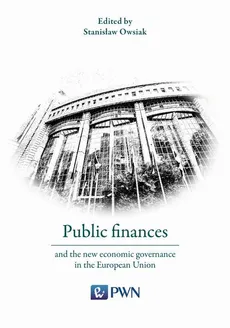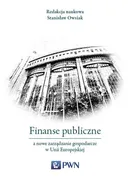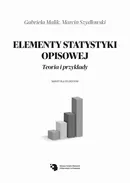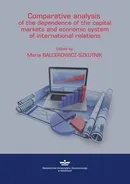Public finances and the new economic governance in the European Union
This work is an attempt to assess to what extent the new economic governance of the EU helped to discipline public finances in the member states.
The poor institutional design of the EU, the authors point out, magnified the negative fiscal effects of the last financial crisis. The work attempts to examine the degree of fiscal consolidation of member states. Both, the austerity policies, as a method of consolidating public finances, and the so-called non-Keynesian fiscal policy effects have been scrutinized. Moreover, the methods of disciplining public finances in Germany, Great Britain, Hungary and Poland have been thoroughly evaluated.
The specific experience of other Member States has also been taken into account while identifying the advantages and disadvantages of current fiscal consolidation strategies. So as to examine the relationship between the budget balance and other macroeconomic variables as well as to identify changes in the economic potential of the member states and in assessing the economic convergence processes, the work relies on quantitative methods.
Prof. dr hab. Stanisław Owsiak – the long-term head of the Chair of Finance at the Faculty of Finance at the Cracow University of Economics, the holder of an honorary doctorate of the University of Szczecin, a member of the Scientific Council of the Polish Economic Society, the deputy chairman of the Committee for Economic Sciences of the Polish Academy of Sciences, a member of The Committee on Financial Sciences of the Polish Academy, member of the Economic Education Board of Narodowy Bank Polski, the chairman of the Main Committee of the Economic Knowledge Contest.
Reviewed book is the original, innovatory work which contributes to the development of finance science as well as macroeconomics. The authors shed new light on the problems of public finances in the member countries of the European Union. Application of well-chosen research methods, including quantitative methods, allowed them to discover many new dependencies and stylized facts in public finances and macroeconomics. This book is useful reading for economists, financiers, political scientists, economic sociologists, students of economic studies, journalists, politicians and for all who are interested in economics and finance.
Prof. dr hab. Sławomir I. Bukowski
Kazimierz Pułaski University of Technology and Humanities in Radom
- Kategorie:
- Język wydania: angielski,polski
- ISBN: 978-83-01-19916-6
- ISBN druku: 978-83-01-19812-1
- Liczba stron: 532
-
Sposób dostarczenia produktu elektronicznegoProdukty elektroniczne takie jak Ebooki czy Audiobooki są udostępniane online po opłaceniu zamówienia kartą lub przelewem na stronie Twoje konto > Biblioteka.Pliki można pobrać zazwyczaj w ciągu kilku-kilkunastu minut po uzyskaniu poprawnej autoryzacji płatności, choć w przypadku niektórych publikacji elektronicznych czas oczekiwania może być nieco dłuższy.Sprzedaż terytorialna towarów elektronicznych jest regulowana wyłącznie ograniczeniami terytorialnymi licencji konkretnych produktów.
-
Ważne informacje techniczneMinimalne wymagania sprzętowe:procesor: architektura x86 1GHz lub odpowiedniki w pozostałych architekturachPamięć operacyjna: 512MBMonitor i karta graficzna: zgodny ze standardem XGA, minimalna rozdzielczość 1024x768 16bitDysk twardy: dowolny obsługujący system operacyjny z minimalnie 100MB wolnego miejscaMysz lub inny manipulator + klawiaturaKarta sieciowa/modem: umożliwiająca dostęp do sieci Internet z prędkością 512kb/sMinimalne wymagania oprogramowania:System Operacyjny: System MS Windows 95 i wyżej, Linux z X.ORG, MacOS 9 lub wyżej, najnowsze systemy mobilne: Android, iPhone, SymbianOS, Windows MobilePrzeglądarka internetowa: Internet Explorer 7 lub wyżej, Opera 9 i wyżej, FireFox 2 i wyżej, Chrome 1.0 i wyżej, Safari 5Przeglądarka z obsługą ciasteczek i włączoną obsługą JavaScriptZalecany plugin Flash Player w wersji 10.0 lub wyżej.Informacja o formatach plików:
- PDF - format polecany do czytania na laptopach oraz komputerach stacjonarnych.
- EPUB - format pliku, który umożliwia czytanie książek elektronicznych na urządzeniach z mniejszymi ekranami (np. e-czytnik lub smartfon), dając możliwość dopasowania tekstu do wielkości urządzenia i preferencji użytkownika.
- MOBI - format zapisu firmy Mobipocket, który można pobrać na dowolne urządzenie elektroniczne (np.e-czytnik Kindle) z zainstalowanym programem (np. MobiPocket Reader) pozwalającym czytać pliki MOBI.
- Audiobooki w formacie MP3 - format pliku, przeznaczony do odsłuchu nagrań audio.
Rodzaje zabezpieczeń plików:- Watermark - (znak wodny) to zaszyfrowana informacja o użytkowniku, który zakupił produkt. Dzięki temu łatwo jest zidentyfikować użytkownika, który rozpowszechnił produkt w sposób niezgodny z prawem. Ten rodzaj zabezpieczenia jest zdecydowanie bardziej przyjazny dla użytkownika, ponieważ aby otworzyć książkę zabezpieczoną Watermarkiem nie jest potrzebne konto Adobe ID oraz autoryzacja urządzenia.
- Brak zabezpieczenia - część oferowanych w naszym sklepie plików nie posiada zabezpieczeń. Zazwyczaj tego typu pliki można pobierać ograniczoną ilość razy, określaną przez dostawcę publikacji elektronicznych. W przypadku zbyt dużej ilości pobrań plików na stronie WWW pojawia się stosowny komunikat.
Introduction 11 Chapter 1. Practical dimension of research on public finances 17 1. Premises for disciplining public finances in the European Union 19 2. Measures undertaken by the European Union to discipline public finances 22 3. Research thesis 25 4. Verification methods 27 4.1. A qualitative and quantitative approach 27 4.2. Fiscal consolidation as the basic tool for disciplining public finances 29 4.3. Budget balance and types of fiscal policy 31 4.4. Methods of examining the relationship between budget balance and macroeconomic variables 33 4.5. The matter of non-Keynesian effects of fiscal policy during the crisis 35 4.6. Method for testing the economic potential of EU countries 36 4.7. Convergence or economic divergence in Europe 37 5. Time scope of the study 38 6. Country selection criteria – case studies 40 Chapter 2. Concepts of fiscal consolidation 45 1. Definitional difficulties 47 2. Controversies over the concept of fiscal consolidation 48 2.1. Problem of the starting point of consolidation 48 2.2. Choice of consolidation strategy and macroeconomic effects 50 2.3. Measuring consolidation 53 2.4. Criteria for assessing the effects of consolidation 55 3. Dilemma regarding the choice of consolidation instruments 55 4. Assessing the sustainability of fiscal consolidation in selected EU countries 59 5. Summary 63 Chapter 3. Fiscal supervision as an element of new economic governance in the European Union 65 1. Treaty bases for coordination of the Member States’ economic and budgetary policies 67 2. Evolution of fiscal supervision 1992–2005 71 3. Fiscal supervision as an element of new economic governance 77 3.1. General concept of change 77 3.2. New requirements for budgetary frameworks of member states 81 3.3. Action undertaken to strengthen the surveillance of budgetary positions and the surveillance and coordination of economic policies 83 3.4. Action to speed up and clarify the excessive deficit procedure 87 3.5. Enforcement of budgetary surveillance in the euro area 90 3.6. Mechanism for preventing and correcting macroeconomic imbalances 91 3.7. Enforcement of correction of excessive macroeconomic imbalances in the euro area 94 4. Further attempts to strengthen fiscal supervision 95 4.1. The Fiscal Compact 95 4.2. ‘The two-pack’ 97 5. Assessment of the reform of the economic governance in the EU 102 6. Conclusion 114 Chapter 4. Austerity as a tool of fiscal consolidation – theoretical and empirical perspective 115 1. Introduction 117 2. Historical debate 122 3. Neoliberalism and financialization 128 4. Macroeconomic performance 131 5. The justification for austerity 136 6. Economic crisis and fiscal policy 143 7. The ideological foundations of supply side economics 153 8. Brexit and its implications for the UK 161 9. Conclusion 164 Chapter 5. Efforts of fiscal consolidation in the United Kingdom 167 1. Introduction – background of the study 169 1.1. The sovereign debt crisis and financial stability 171 1.2. The United Kingdom’s Fiscal Stability Code 171 1.3. The Maastricht Treaty and fiscal rules 172 2. The pre-crisis overview 175 2.1. Macroeconomic imbalances in the UK 175 2.2. State of public finances before the crisis 178 2.3. Budgetary forecast before the crisis 179 3. Analysis of the financial crisis period 180 3.1. Public sector net debt 182 3.2. Relative projections and economic performances 183 3.3. Output gap and real GDP 185 3.4. The structural deficit 186 4. Efforts of fiscal consolidation 188 4.1. Policy implementation under Labour government 188 4.2. Policy changes under coalition government 189 4.3. Policy effects on the UK economy 192 4.4. The UK’s public finances and Brexit 194 4.4.1. The mechanical effect 194 4.4.2. The national income effect 195 5. The policy decision and summary 196 Chapter 6. Fiscal consolidation in the Federal Republic of Germany 199 1. Characteristics of fiscal policy in the Federal Republic of Germany 1999–2007 201 2. Reforms in the public expenditure system 217 3. Changes in the public revenue system in the years 1999–2007 220 4. Characteristics of fiscal policy in the Federal Republic of Germany 2008–2015 224 4.1. State interventionism in response to the crisis: 2008–2010 224 4.2. Savings policy implemented by the Federal Republic of Germany in 2011–2015 231 5. German fiscal policy and the business cycle 235 6. The problem of common monetary policy 242 7. Socio-economic effects of the fiscal policy of the Federal Republic of Germany 247 8. Summary 252 Chapter 7. Fiscal consolidation strategies in Hungary 255 1. Introduction 257 2. Excessive deficit in Hungary and scenarios for its correction 258 3. Medium-term budgetary objective 264 4. Public debt in Hungary 266 5. Instruments for disciplining public finances on the expenditure side 269 6. Scenarios of expenditure adjustments and their implementation 272 7. Instruments for disciplining public finances on the revenue side 276 8. Scenarios of revenue adjustments and their implementation 281 9. Institutional changes favouring fiscal consolidation 288 10. Evaluation of fiscal consolidation 289 11. Economic effects of fiscal consolidation 292 12. Macroeconomic imbalances in Hungary in the period of fiscal consolidation attempts 299 12.1. Internal imbalances 299 12.2. External imbalances 302 13. Conclusions 303 Chapter 8. Strategies of fiscal consolidation in Poland 305 1. Introduction 307 2. Fiscal consolidation in Poland in 2003–2008 308 2.1. Adaptation measures to the nominal fiscal convergence criterion 308 2.2. Changes on the revenue side of government institutions sector and local government 320 2.3. Actions to reduce public spending 323 3. Impact of 1999 pension reform on the condition of public finances in the period 2004–2015 329 4. Fiscal policy in Poland in response to the global financial and economic crisis 338 4.1. New solutions adopted in the Public Finance Act of 2009 338 4.2. Disciplining public finances in Poland after launching the excessive deficit procedure in 2009 344 5. Summary 358 Chapter 9. Testing the dynamic relationships between the public financial sector deficit and the macroeconomic variables in selected EU countries 361 1. Description of the testing procedure 363 2. Dynamic modelling results in selected EU economies 366 2.1. Poland 369 2.2. The United Kingdom 371 2.3. Hungary 371 2.4. Germany 373 2.5. France 374 2.6. Sweden 375 3. Analysis of the impulse response function 377 4. The results of Granger causality test 383 5. Summary 386 Annex 387 Chapter 10. The impact of the financial crisis on the distribution of total power across the member states of the European Union 395 1. Introduction 397 2. The measurement of power and its distribution in the European Union 399 2.1. The applicability of the power model and its core components 399 2.2. The distribution of power in the European Union 406 2.3. Total power and stability at the onset of the recession in the EU 410 3. Shifts in the stability of total power 413 3.1. The position during the recession 413 3.2. The position after the recession 418 3.3. Economic potential and public spending in the Baltic states 421 4. The impact of the crisis on the Baltic states and their fiscal responses 422 4.1. Changes in GDP output from 2006 to 2014 422 4.2. Changes in the structure of total power and its causes – Poland and the Baltic states 424 4.3. Drivers of growth and debt compared 427 5. Conclusion 429 Chapter 11. Process of economic convergence of European countries 433 1. Initial remarks 435 2. Models for cross-section and time-series variables configuration 436 3. Methods for stratified analysis 441 4. Initial analysis of GDP per capita ratios variation in European countries in 1950–2015 444 5. Analysis of moveable dynamics indexes for GDP per capita ratios in European countries 449 6. Analysis of the ranking of European countries by GDP per capita ratios in selected years 452 7. Summary 457 Chapter 12. Options for disciplining public finances – synthesis 459 1. Condition of public finances as a result of various factors 461 2. Assessment of the impact of fiscal stimulus on public finances in the European Union countries 462 3. Convergence or divergence – research results 467 4. Case study on the assessment of disciplining public finances in the surveyed countries 468 5. Evaluation of fiscal consolidations 486 6. Evaluation of the role of new public governance in disciplining public finances 493 7. Variants for achieving public finance discipline – conclusions for Poland 498 Annex 503 Bibliography 509




























































